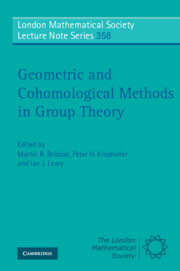Book contents
- Frontmatter
- Contents
- Preface
- List of Participants
- Notes on Sela's work: Limit groups and Makanin-Razborov diagrams
- Solutions to Bestvina & Feighn's exercises on limit groups
- L2-Invariants from the algebraic point of view
- Constructing non-positively curved spaces and groups
- Homology and dynamics in quasi-isometric rigidity of once-punctured mapping class groups
- Hattori-Stallings trace and Euler characteristics for groups
- Groups of small homological dimension and the Atiyah conjecture
- Logarithms and assembly maps on Kn(Zl[G])
- On complete resolutions
- Structure theory for branch groups
L2-Invariants from the algebraic point of view
Published online by Cambridge University Press: 07 September 2011
- Frontmatter
- Contents
- Preface
- List of Participants
- Notes on Sela's work: Limit groups and Makanin-Razborov diagrams
- Solutions to Bestvina & Feighn's exercises on limit groups
- L2-Invariants from the algebraic point of view
- Constructing non-positively curved spaces and groups
- Homology and dynamics in quasi-isometric rigidity of once-punctured mapping class groups
- Hattori-Stallings trace and Euler characteristics for groups
- Groups of small homological dimension and the Atiyah conjecture
- Logarithms and assembly maps on Kn(Zl[G])
- On complete resolutions
- Structure theory for branch groups
Summary
Abstract
We give a survey on L2-invariants such as L2-Betti numbers and L2-torsion taking an algebraic point of view. We discuss their basic definitions, properties and applications to problems arising in topology, geometry, group theory and K-theory.
Key words: dimensions theory over finite von Neumann algebras, L2-Betti numbers, Novikov Shubin invariants, L2-torsion, Atiyah Conjecture, Singer Conjecture, algebraic K-theory, geometric group theory, measure theory.
MSC 2000: 57S99, 46L99, 18G15, 19A99, 19B99, 20C07, 20F25.
Introduction
The purpose of this survey article is to present an algebraic approach to L2-invariants such as L2-Betti numbers and L2-torsion. Originally these were defined analytically in terms of heat kernels. Since it was discovered that they have simplicial and homological algebraic counterparts, there have been many applications to various problems in topology, geometry, group theory and algebraic K-theory, which on the first glance do not involve any L2-notions. Therefore it seems to be useful to give a quick and friendly introduction to these notions in particular for mathematicians who have a more algebraic than analytic background. This does not mean at all that the analytic aspects are less important, but for certain applications it is not necessary to know the analytic approach and it is possible and easier to focus on the algebraic aspects. Moreover, questions about L2-invariants of heat kernels such as the Atiyah Conjecture or the zero-in-the-spectrum-Conjecture turn out to be strongly related to algebraic questions about modules over group rings.
Information
- Type
- Chapter
- Information
- Geometric and Cohomological Methods in Group Theory , pp. 63 - 161Publisher: Cambridge University PressPrint publication year: 2009
Accessibility standard: Unknown
Why this information is here
This section outlines the accessibility features of this content - including support for screen readers, full keyboard navigation and high-contrast display options. This may not be relevant for you.Accessibility Information
- 6
- Cited by
